Sign up for our Newsletter 86 Falls Road, Shelburne, Vermont 05482 10:00-5:00 Tues through Fri & 10:00-4:00 Sat (802) 985-3848 | directions
March 25 – May 7, 2022
******Exhibit Extended through May 14th!******
Join Us for a Reception Friday, April 29th, 5 – 7pm
Beginning in early spring of 2021 four artist friends began a weekly journey into the unexplored topography of textile bringing with them needle, thread, curiosity, and each other’s encouragement.
Sarah Ashe | Janet Fredericks | Kari Hansen | Lily Hinrichsen
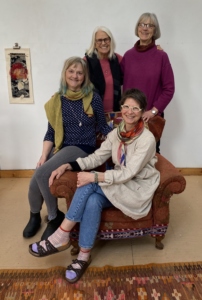
There is a wildness in our approach to this age-old art of needlework. With little experience and much enthusiasm about this medium we decided, in our initial gathering, to jump in and follow our instincts. We came to it as painters — free of conventions, unencumbered, and joyfully fierce. We let our minds and needles wander, exploring a new territory of pattern, color, and process which we call feral stitching.
In our early days together we challenged ourselves by each of us selecting the same fabrics, then taking them home to stitch our interpretations. A week or two later we came together again to share our creations. The excitement of seeing each other’s work provided inspiration, further explorations, and technical learning that transcended the work itself.
As the weeks and months passed we each began to find our own methods and aesthetic. We shared fabric, embroidery floss, ideas, and discoveries from stitchery books and other cultures. It has been, and continues to be, a rich exploration where our backgrounds in other art disciplines inform our work, and where we find the comfort of collaboration in these uncertain times.
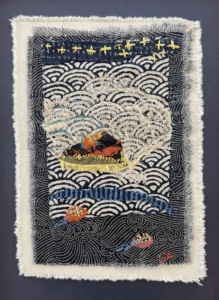
Seeking Refuge
Sarah Ashe (View Gallery)
During the pandemic as my world shut down to museum and gallery visiting opportunities, I left my painting practice and turned to stitchery. Creating with fabric (patterned, see-through, worn, old painting rags, plastic bags, etc) and sewing in colorful stitch marks while holding the fabric in my hands, provided a comfort and intimacy to my art making that I needed. Making marks with a wide array of embroidery thread is not unlike a study in my sketchbook where the build up of line defines form. This quiet activity of looking and marking is a kind of meditation that I treasure in my art practice.
As with any new excursion, reading and researching have led to new discoveries. Boro, the Japanese art of mending, sparked an interest in indigo dyed fabric, some I bought and some I dyed. The dying led to trying onion skins, black walnuts, and rusty screws and bolts from my husband’s stash of old fasteners. Fabric is also sourced from second hand stores, upholstery samples, feral stitching friends and my own closet…cutting off the ends of sleeves and hems of favorite shirts as well as repurposing other’s worn and out of style treasures.
The collaboration with our Feral Stitching Group continues to be a catalyst for deeper exploration, technical “how to” teaching and the supportive critique and encouragement so lacking in isolated days.
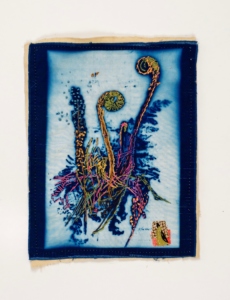
Sensitive Fern and Fertile Stalk
Janet Fredericks (View Gallery)
As a young child I loved playing with the fabrics in our sewing room. I would delight in the colors and textures of these materials while draping them around my mother’s dress form or making clothes for my doll with basic hand stitching. As a young teen I took lessons on my mother’s new Singer sewing machine and began mending and making my own clothes. From patterns I constructed skirts, blouses, dresses, jackets, a suit and even a wedding dress of silk peau de soie with covered buttons and a hat learning the patience and focus necessary. I am grateful to mother for having encouraged me in this creative and useful craft. After years of focusing on a career of painting and drawing I have come full circle to needle and thread and fabric in a very different way. My love of layering color and texture has found its way into my studio through layering up and hand stitching old monotype prints, film, drawings, miscellaneous materials such as shelf fungus, leaves, and twigs, and plastic netting. While stitching I watch myself falling into order, placing materials together then letting go of preciousness to allow my my hand and needle and intuition to take the lead. It’s like reverse excavation…layering up the fragments of my life; six decades of creative expression evident in these works. Here in one’s hand is a story told and retold, reinvented, past and passed on…evidence of a hand-made world of shapes hinting at something vaguely familiar and deeply felt, my imagination untamed and wild… inscrutably and undoubtedly feral.
Together with my “feral sisters’ I’ve enjoyed the camaraderie of working together, challenging each other, sharing techniques and materials, and inspiring each other throughout this past year. A note on the cyanotypes: This project started during the first year of the Covid pandemic. I wanted to document the great variety of ferns along my dirt road. In experimenting with this photographic process I added other plants and household items. The small stitched “chop” is a nod to Japanese prints. This process dates back to the early 1800s when pioneer/photographer Anna Atkins used blueprints to document her collection of seaweed. This color blue, although it is not true indigo, has always held a spiritual significance for me.
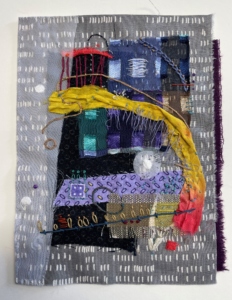
The Slippery Slope of Technology
Kari Hansen (View Gallery)
For over 30 years, I have been an interior woodwork designer, dreaming about spending time on my own artwork in my studio. I am so grateful to be working with a group of wonderful, talented women. We’ve been painting, collaging, creating together, during the Covid 19 lockdown we continued on zoom, each of us in our own studios, apart but together. In 2021, along came our great feral stitching exploration, sharing ideas, fabric, skills, materials.
My stitching process of creating and composing is different, more a gradual buildup, than when I am painting-where I can swipe a brushstroke, splash, paint over, scrape back, boldly layer. My stitching starts with pieces of fabric placed in a composition, then the stitching, which is slow stitch by stitch, where the composition changes, more fabric, overlapping, transparent fabrics, more stitching and yet another compositional change and then, another and another. Even just one stitch informs the others. Many layers, but in contrast to the way I paint, it is gentler, slower, more thoughtful.
I love having a new medium to dive into, the collaboration, the sharing of ideas and learning. I can feel that I am a part of a long tradition through time of women stitching together, quiet, meditative, a peacefulness in this sometimes too busy, fast-paced world. I have had a needle and thread in my hand for as long as I can remember, and sewing on the same Necchi sewing machine for over 60 years. I am indeed hooked.
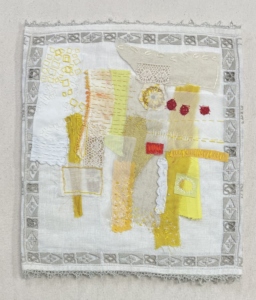
Breaking Tradition
Lily Hinrichsen (View Gallery)
Hand stitching is slow. I appreciate this unhurried pace. It’s challenging, as well. Sometimes as I create a piece I feel it needs a bold stroke of color, which, if I were painting, I would create instantly with brush and pigment. With hand stitching I must cut it from fabric or stitch it slowly across the piece. It is a process that forces me to think and feel beyond impulsiveness. To sit patiently with each stitch as it unfurls and each scrap of fabric as it joins the composition. It’s a slow, thoughtful conversation.
I have no past experience with embroidery or sewing methods. I have much experience with printmaking, painting, and collage, so when I first gathered with Janet, Sarah, and Kari and the suggestion of a collaboration using only fabric and stitching was presented, I was both wary and curious. That was a year ago. In that year I have grown into this new way of expressing myself through their encouragement, shared materials, and shared knowledge. Hand stitching has become a daily ritual of sorts. A time that I carve out to sit quietly, head bowed and let color and texture tell a story. My pieces are influenced by Aboriginal art, nature, birds, home, fear, whimsy, the joy of circles. Frayed edges, holes, stains, knotted threads – all these “blemishes” become intriguing characteristics of the piece; the appeal that draws me in and makes the piece more relatable. I have found a new medium that speaks to me.
Rutland Herald ‘Conversations in Art’ May 14 2022
Conversations in Art: ‘Feral Stitching: FourArtists Go Wild’
B. Amore Arts Correspondent
‘With little experience and much enthusiasm”
Furchgott Sourdiffe Gallery in Shelburne has always had a unique perspective in curating
shows. This gem of a gallery was founded by Joan Furchgott and Brad Sourdiffe in 1991.
In 2020, they sold the business to another talented couple, Lara Maloy, a longtime
employee, and Nico Sardet, graphic designer and master woodworker.
The long tradition of innovative exhibits was upheld when the gallery featured “Feral
Stitching — Four Artists Go Wild,” March 25-May 7, the debut of experimental fabric art
by Sarah Ashe, Janet Fredericks, Kari Hansen and Lily Hinrichsen.
Fredericks, a longtime gallery artist, introduced the other three to Maloy and Sardet with
a proposal for the exhibit. Maloy states, “The positive energy of their creative
camaraderie was very evident when Nico and I first met with them at the gallery to
explore a sample of their fabric pieces and meet up in person. Now, I have to admit that
fabric art has never been peak on my radar. I think it’s challenging to see it in the same
respected light as other mediums, but I’d like to dispel this bias. The pieces in this exhibit
completely refused to be limited — hence ‘Feral!’”
This is a quintessential Vermont story, one of personal connections creating new
opportunities. Four experimental painter-friends with varying degrees of sewing skills
from zero to accomplished, embarked on a journey together in Spring 2021. Their
“manifesto” states, “There is a wildness in our approach to this age-old art of needlework.
With little experience and much enthusiasm about this medium we decided, in our initial
gathering, to jump in and follow our instincts. We came to it as painters — free of
conventions, unencumbered and joyfully fierce. We let our minds and needles wander,
exploring a new territory of pattern, color and process, which we call feral stitching.”
Needlework has traditionally been the purview of women throughout history and was an
important part of women’s identity in the Victorian Age. In fact, it became a mode of
social interchange with the lady of the house engaged in executing fancy embroidery
work while entertaining guests. This decorative stitching was distinguished from the
plain sewing executed by hired help.
During the COVID pandemic, Zoom became the “living room” and domain of exchange.
Just as Victorian women expanded their limited lives through creative stitchery, Ashe,
Fredericks, Hansen and Hinrichsen took up the challenge of reduced contact and used
the space provided to expand their art forms. The combination of the artists’ generative
energies and the gallerists’ open minds created this absolutely unique and stunning
exhibit. The artists words are revelatory and share with us their open-ended process of
exploration.
Kari Hansen
B.A.: You talk of being an interior woodwork designer. What was your studio practice
before Feral Stitching?
K.H.: Designing interior woodwork, an intense fast-paced and very detail-oriented work,
took up 30-plus years of my life, and I loved it. One of my favorite parts was meeting new
people, seeing them in their homes, listening to what they wanted and what was
important to them. Everyone is so uniquely different. I was lucky because I got trained to
understand and learn both the design and the construction of what we were building. I
have always worked in my studio, squeezing in time for painting, drawing, calligraphy,
book-making, pottery, sewing, knitting, embroidery, tinkering.
B.A.: What is the relationship to fabric in your own life and the tradition of women
stitching together?
K.H.: When I was a little girl, I would imagine other women learning handwork and the
sewing skills I have, and the knowledge being passed through the ages. I have a beautiful
1864 sampler from my great-great-grandmother. A few of the letters are not in the
correct order and some are missing. I understand that when one completes a beautiful
intricate letter it may be too painful to pick out the tiny stitches!
My Norwegian-born mother was a great influence. She was an incredible seamstress and
supplied me with mounds of all sorts of materials for me to experiment with. One high
school summer, working from 6 in the morning to noon, I sewed over 250 custom bikinis
for a bikini boutique. I’d drop the finished pieces off after lunch, pick up a new batch, and
then I’d spend the afternoons playing beach volleyball. Back on the 6 a.m. schedule the
next day.
My father, an artist, worked at home. All sorts of artistic characters would troop in and
out. That certainly made a great impact on me. In my childhood, I learned a lot about art
making, design, and techniques without realizing it at the time. I was soaking it all up.
B.A.: What is the difference between painting and stitching in your art? You seem to use
a collage technique.
K.H.: I can see that both the detailed woodwork design I did and the freedom I felt
growing up with the exposure and the variety of art and sewing supplies have played a
part in my feral stitching. I appreciate the freedom of not knowing where I am going but
moving ahead and stitching on. The feral stitching is similar to painting for me. In both I
am focused on composition and color, but the pace of stitching slows me down. Instead
of swiping a paintbrush across a broad surface, it’s a single stitch at a time. There is a
quality of collage in it too with the piecing of fabric. Sometimes, to feel complete, all I
need is just one more little stitch.
This collaboration has been delightful working with these wild, wonderful feral women
artists. We all generously brought our own uniqueness to share with each other.
Lily Hinrichsen
B.A.: What was it like to embark on this process with no experience in sewing?
L.H.: Curiosity is my life force so embarking on new experiences isn’t difficult for me. It
can be frustrating or disenchanting but not difficult to make the leap. And with these
three supportive friends sharing the experience with me, the landing was made all the
more smooth and delightful. We all owned up to lack of measurable experience in this
medium of needle and thread, so our/my expectations of perfection or precision went out
the window. Instead, we agreed on letting the imperfections reveal themselves. Be visible
for all to see. Holes, knots, frayed edges, loose threads, crooked borders — all of it an
expression of our creative voice, my creative voice, unattached from society’s expectation
of what art should be. Thus, the term “feral” was born. I really like this idea of wildness
with a “domestic” craft. Great play on words.
B.A.: How did you learn different techniques? What was the role of the group in
sharing, assisting you?
L.H.: It was quite natural that the regular meetings of our foursome would result in
mutual trust, support and guidance. So, as each of us found a relevant book or website,
art exhibit, or article, we would share that with each other. This was definitely true of
stitching methods, hanging and exhibiting systems and where to find resources for
repurposed fabric, floss, thread and other tools and materials. Within the first few weeks
we began swapping and sharing fabrics from our stashes or thrift-store finds. That’s how
the collaborative pieces came about — each of us using the same fabrics to see how we’d
interpret them into a piece. I loved that part.
B.A.: What is the relationship of this work to your usual studio practice?
L.H.: In some ways I think it’s dramatically different because, generally, I do oil painting,
monotypes on paper, and collage, but in reality when I step back, I can see similar motifs,
shapes, colors in my hand stitching as in other mediums. That was a surprise to me. I
initially found the stitching to be so slow as to hamper my usual impulsiveness —streaks
of paint dashed across the canvas, for instance. But soon I found a rhythm in the slow
pursuit of punching needle and thread in and out of fabric. I struck a more pensive and
reflective cadence with plenty of time to change fabrics, change thread color, change the
design. This contemplative approach reminded me of my knitting practice, which has
served as healer of my soul and saved me many a therapy appointment.
Janet Fredericks
B.A.: Could you talk about your history with fabric?
J.F.: My mother sewed outfits for my sister and me when we were young. I used to play
with the fabric scraps draping them on her dress form and making my doll clothes from
cast off pieces of colorful material. When I learned to sew using her new Singer sewing
machine, I made some of my own clothes inspired by fashion magazines like Vogue and
other magazines my mother had.
There was a small room in the attic of our old house that must have informed my love of
textiles. It had one small window and a bare light-bulb illuminating those garments put
away for safe keeping or a special occasion. It smelled a bit musty, but this dimly lit space
was a treasure trove of textures, exotic clothing so inviting to explore that I loved to visit
it often. I remember my mother’s wedding dress and an old silk-embroidered Chinese
robe, part of which is in this exhibit, my father’s white-linen tux, furs and old coats all
hanging together. Their stories were untold but fertile and nourishing for my feral
imagination.
B.A.: Do you think you would have used fabric in your art if not for COVID?
J.F.: Yes, I had already used fabric in my artwork before COVID and before working with
my friends stitching. My drawing and painting tend often to be layered whether with
paint or something else. What was new was the experiment in embroidery. Our
collaboration has taught me a lot about using the medium as another way of drawing.
B.A.: How did you come to use cyanotype?
J.F.: I’m drawn to the deep hue of indigo; for me it is a spiritual color. Cyanotypes
historically are the original blueprints and as a photographic medium are useful to me for
documenting the ferns and other plants along my road and in my gardens. The
cyanotypes on exhibit are made on photosensitive fabric exposed outside in the sun. I use
actual plant material laid directly of the fabric and let the sun turn the fabric blue. I have
also used high-contrast negatives to get an image as well. It is quite a simple process.
Sarah Ashe
B.A.: Why did you leave your painting practice during COVID?
S.A.: I think I was ready for a break, having had a show of my work at the Green TARA
space gallery in North Hero, and being in a kind of in-between place afterwards. I had
recently joined the SDA (Surface Design Association) and was pulled by the use of fabric
and stitches, the intimacy and warmth of holding the work in my hands, its portability
allowing me to work anywhere and a revisiting of the work I did 45 years ago, when my
children were young when I made fabric and stitched masks.
B.A.: What draws you to your inventive use of materials and their relation to your art
practice?
S.A.: Much of the art I do is created out of found items — the insides of garlic heads,
teabags, pods. I’ve enjoyed making collages as well, finding images and textures that can
be turned into something new. Searching for fabrics and materials to collage into to a
canvas for stitching offered a wonderful opportunity to open my eyes further, stretch
boundaries and experiment. There is a satisfaction in bringing a familiar item into new
focus, exploring properties and suggestions outside of the assumptions one makes about
the things we encounter and live with.
B.A.: Can you elaborate on the Japanese tradition of Boro and the practice of dying
fabric and its place in your work?
S.A.: The story of the beginnings of Boro started with people in a very poor community in
Japan patching their only pair of pants or kimono with whatever fabric they could find to
ensure something to wear. Patch upon patch, and now these simple garments hang in
museums, a testament to the craftsmanship, beauty and resilience of the human spirit. I
also connected viscerally to the indigo color and discovered Japanese fabric in various
prints that I also incorporated.
Faced with the luxury of materialism, owning too much and losing touch with what is
essential, I wanted to learn something from Boro. Could I find and use what was available
to me? The onion skin and black walnut dyes came from this idea; also, that rust stains
made new patterns. I connected to these self-created patterns and want to continue to
explore them. It also relates a bit to the art I do concerning refugee populations, using
and finding beauty in what is available — adding one’s own marks.
I can’t leave this writing without mention of the Feral Sisters. The connection and
exploration through the isolated months of COVID was a gift to my creative soul.
Exploring this medium, new in varying degrees to all of us, created an excitement and
equal playing field in which we could unselfconsciously share our discoveries, bits of
knowledge and materials. The energy created kept me up into the late hours of the night,
with an engagement so intense I’d often wake with a whole new set of ideas that needed
to be pursued. Lily gave us our name in a burst of humor — it worked!
















